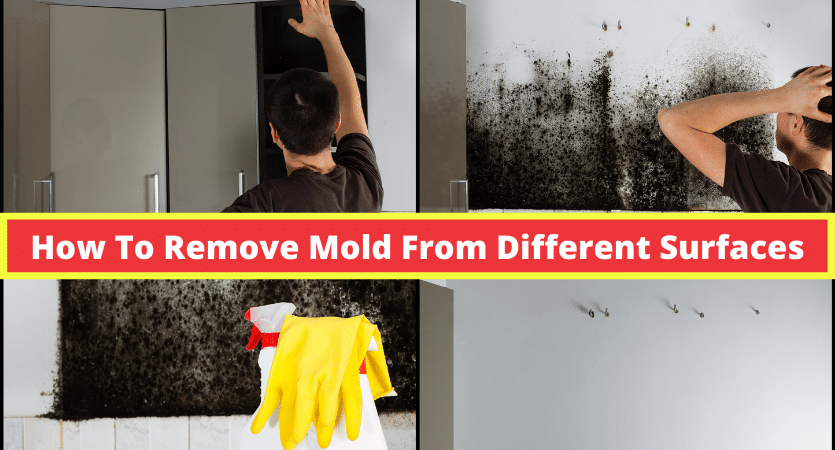
Mold can be found everywhere in our environment. It is a type of fungus, and while some of them are advantageous, others aren’t. A specific type of mold called mildew exists in our homes and it can be quite dangerous.
Removing mold from various surfaces can be a rather hectic task. It may exist in every corner and crevice of your home. Mildew loves a damp environment so it’s usually found in places like washrooms and kitchens. Mold infestation is not only aesthetically displeasing, but can also be deadly. In this article, we’ll look at useful hacks on how to remove mold from different surfaces.
Hire Professionals:
If the mold infestation gets out of hand to the point where large colonies of mold develop, it’s a good idea to hire some professional help. Sometimes, the infestation is so much that it’s almost impossible for you to manage it yourself. Experts suggest that removing colonies on a larger scale requires several chemicals and proper disposal of these colonies. Usually, an individual can clear away a mold colony of less than 10 square feet. However, if the infestation is greater than this, you should call in the cavalry.
Removing Mold from Fabric:
Removing mold from fabrics can be quite the trick. If they’ve been infected for far too long, it may become impossible to save them. However, if the mold has recently started growing, you should take the fabric and head out of the home. Heading out is important so as to not redistribute the very mold you are trying to eliminate from the house. Brush as much mold off as you possibly can. Afterward, if the fabric is washable, put it in hot water and let it stay there for 8 hours. You can also add a disinfectant to enhance the cleaning process.
Once done, take the fabric out and you’ll notice all the mold will be gone. For fabrics that can’t be washed, once you’ve brushed them, head over to a specialist and they’ll take it from there.
Removing Mold from Brick
If your walls become infested, removing mold from them can be a challenging task, to say the least. Bricks are usually coated with paints and if bricks are infected it’s quite difficult to clean them. If a brick is painted then cleaning brick here can be quite difficult. For this purpose, you need to find the source of moisture first. Mold grows due to moisture content; this is why it’s mostly present in corroded areas. To remove it from bricks, the first step is to control the moisture content.
Once you’ve taken care of the moisture content, you need to use vinegar to clean the bricks. Ensure that you’ve taken the necessary precautions because inhaling mold can have dire consequences. You can also use vinegar to clean the surface if you prefer a more natural approach to cleaning than typical disinfectants provide.
Removing Mold from Leather Shoes and Furniture:
To remove the mold from leather accessories or furniture, it needs to be taken out first. Take it out so that if the mold infects the air, you’re safe from it. Once you’ve taken the furniture outside, wipe it with a cloth. You can dip the cloth in vinegar to thoroughly clean it. It’s a good idea to use a bar of soap and warm water for this purpose. Once cleaned with a damp cloth, you can dry it with a dry cloth. Moreover, you can also use a leather conditioner afterward to give it a shine.
Removing Mold from Books and Papers:
Removing mold from paper is also pretty difficult because paper is a fragile material. For removing mold from paper, ensure that the paper is dry because if you try to work with damp paper, the mold will be smeared. You can use the sun to your advantage. Place the books or paper in the sun and allow it to try. Moreover, you can also store the infected paper in a sealed container and add a moisture-absorbing agent. When the pages are completely dry, take them out and use a brush to clean them gently. Lastly, you can use a small amount of hydrogen peroxide on a cloth and wipe the pages with it.
Removing Mold from Household Appliances:
Certain appliances that are exposed to water can also be affected by mold. To clean a washing machine you can add chlorine and run a wash cycle at least once a month. Moreover, if your clothes smell of mold, you need to inspect every inch of your washer to see if it is infested. If you’re cleaning a fridge or coffee maker, you can use distilled white vinegar to clean them rather than chlorine bleach.
Final Say:
Mold growth in any place can be quite disturbing. It disrupts the physical properties as well as the appearance of an item or place. It grows on several surfaces and the major driving factor for mold growth is moisture. It’s a good idea to familiarize yourself with the various methods of cleaning surfaces to rid them of mold.
Leave a Reply